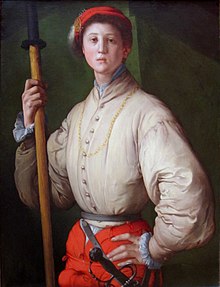Nestelband
A nesting ribbon (also: laces, nestling cord , braided loop cord ) is a ribbon made from different materials and using different techniques.
history
Woven ribbons or ribbons made of different materials have a long tradition in different cultures. In Central Europe, the nesting ribbon spread from the 12th century with the onset of the first forms of body-hugging fashion, closed by nesting ribbons, and is used for fastenings. From the late Middle Ages onwards, a multitude of uses can be demonstrated, which is promoted in particular by the now common fashion of tight, body-modeling clothing. Various surviving books, for example the Tollemarch book of household, describe techniques for making textile ribbons using finger loop technology, but there are also findings from leather ribbons. There are equivalent applications and manufacturing techniques in Asia, for example the Japanese Kumihimo .
manufacturing engineering
Nesting ribbons can be made from various materials, such as cut leather ribbons, or from textile material by hand using finger loop technology (finger loop, finger loop). In this technique, long loops made of textile material (mostly silk, but also wool or linen) are knotted and placed over individual fingers of the hand. By exchanging or pulling the loops, they are woven into a very stable, tear-resistant cord.
use

In Central Europe, nesting straps are detectable for fastenings of all kinds in the period from around 1200–1600, but the main application is due to the tight, body-hugging and modeling fashion in the 14th century from around 1350 as clothing fastening by means of lacing . For this purpose, holes were made in the fabric and bordered with a buttonhole stitch, or the nestles were pulled through metal eyelets. Another application is the connection of two items of clothing, such as the leg warmers on the brouche or the doublet on the trousers . In addition, ribbon ties were sewn onto clothing as a decorative element and used to close bags, such as alms bags .
Nestlips
The ends of the nesting straps were often provided with metal sleeves, the so-called "nesting tips", to make it easier to guide them through the holes or eyelets . The tips were made from sheet metal that was cut out and hammered into shape. They were either pressed onto the nest or riveted through a hole in the bag-shaped tip of the nest.
etymology
The tying of nestle cords, the "nestling", has remained in parlance to this day as a term for a non-purposeful or uncoordinated activity, often in connection with clothing, strings or fasteners. The "nestle knotting" referred to a damaging spell that causes the inability to reproduce and is named after the lacing strap (nestle) on the man's trousers. Likewise, the word shoelace is derived from the original word "lace" in some areas of Germany for this type of lace.
literature
- Elisabeth Benns, Gina Barret: Tak V Bowes departed - a 15th century braiding manual examined . Soper Lane Verlag, ISBN 0-9542380-6-0 (English)
- Noémi Speiser: Old english pattern books for loop braiding . Self-published
- Geoff Egan, Frances Pritchard: Dress Accessories, c.1150-c.1450 . Boydell Press Verlag, ISBN 0-85115-839-0 (English)
Web links
- Finger loop instructions with seven loops
- Information about late medieval nest makers
- Sources and pattern instructions (English)
Individual evidence
- ^ Britta-Juliane Kruse: Impotence. In: Werner E. Gerabek u. a. (Ed.): Encyclopedia of medical history. De Gruyter, Berlin / New York 2005, ISBN 3-11-015714-4 , p. 664.

